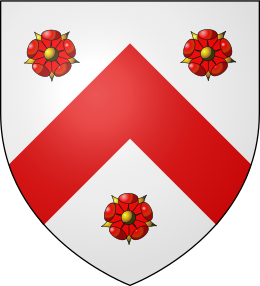Clan Wedderburn facts for kids
Quick facts for kids Clan Wedderburn |
|
|---|---|

Crest: An eagle's head erased Proper.
|
|
| Motto | Non Degener (Not Degenerate |
| Profile | |
| Plant badge | Beech |
| Chief | |
 |
|
| Henry David Scrymgeour-Wedderburn | |
| Lord Scrymgeour | |
| Historic seat | Blackness House |
Clan Wedderburn is a Scottish clan from the Lowlands. A "clan" is a group of families who share a common ancestor and a strong sense of community. The Wedderburns have a long history in Scotland, with their story stretching back many centuries.
Contents
History of Clan Wedderburn
Where the Clan Began
The first person named Wedderburn in Scottish records was Wautier de Wederburn. He showed loyalty to Edward I of England in 1296. The original lands of the Wedderburn family were in an area called Berwickshire. Other early records mention John de Wedderburn in 1364 and William de Wedderburn between 1426 and 1452. However, the Wedderburn lands later became part of the Clan Home territory.
After a period of less influence in the Scottish Borders, the Wedderburn family moved to Forfarshire. By the 1400s, there were four related Wedderburn families living in Dundee and Kingennie in Forfar.
Important Figures in the 1500s and 1600s
One of the Dundee families included James Wedderburn. His three sons, James, John, and Robert, were early supporters of the Protestant Reformation in Scotland. They worked together to write famous religious songs called the "Guide and Godlie Ballads," also known as the Wedderburn Psalms.
From the oldest brother, James, came James Wedderburn, who became a Bishop in 1636. He was a friend of Archbishop Laud. Because of his role in changing church practices, he had to leave Scotland in 1638. He moved to Canterbury in England and is buried in Canterbury Cathedral.
Robert Wedderburn, the third brother, had a grandson named Alexander Wedderburn. This Alexander was a clerk in Dundee from 1557 to 1582. His son, also called Wedderburn of Kingennie, was a favorite of James VI of Scotland. He traveled with the king to England in 1603. When he returned, the king gave him a special ring. This direct family line ended in 1761 with David Wedderburn's death. His family's properties then went to the Clan Scrymgeour, who added "Wedderburn" to their name.
David Wedderburn's brother, James, had a son named Alexander Wedderburn of Blackness. This Alexander was one of the people who helped with the Treaty of Ripon in 1641.
The 1700s and Jacobite Risings
Blackness House in Dundee was a home for a part of the Clan Wedderburn during the 1600s and 1700s. Sir John Wedderburn of Blackness joined the British Army. He passed away in 1723 after selling Blackness House to his cousin, Alexander. Alexander then became the next Baronet.
However, Alexander lost his job as Clerk of Dundee because he supported the Jacobite cause. The Jacobites wanted to bring the old royal family back to the throne. His oldest son, Sir John Wedderburn, 5th Baronet of Blackness, also supported the Jacobites. He fought as a volunteer in Lord Ogilvy’s army. He was captured at the Battle of Culloden in 1746. He was later executed for his actions, and his title was taken away, a process called "attainder."
His oldest son, John Wedderburn of Ballindean, also fought at Culloden but managed to escape to Jamaica. Several family members, including his second son, James Wedderburn-Colville, became wealthy through businesses in the West Indies or through trading in London.
In 1775, David Wedderburn of Balindean became the chief of the clan. He was also a Member of Parliament for Perth and the Postmaster General for Scotland. He was also given the title of Baronet. Alexander Wedderburn, a descendant of Judge Sir Peter Wedderburn, became a very important lawyer. He spoke out against the British government's actions in the American colonies, predicting they would become independent. He was given the title Lord Loughborough in 1780 and later Earl of Rosslyn in 1801.
Clan Chief Today
The leader, or chief, of the Wedderburn family is now part of the Scrymgeour-Wedderburn family, who are also the Earls of Dundee. By agreement, the chiefship of Clan Wedderburn is held by the eldest son of the Earl. This son is also the chief of the Clan Scrymgeour. When the Wedderburn chief becomes the Earl, the chiefship then passes to his heir.
Clan Castles
- Blackness House, a large home in Dundee, was owned by the Wedderburn family from the mid-1600s to the early 1700s. (This is a mansion, not the old Blackness Castle near the River Forth).
See also

